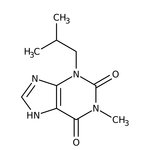Search Thermo Fisher Scientific
Thermo Scientific Chemicals
3-Isobutyl-1-methylxanthine
CAS: 28822-58-4 | C10H14N4O2 | 222.25 g/mol
| Catalog Number | Quantity |
|---|---|
| ALFJ64598.MC | 100 mg |
Catalog number ALFJ64598.MC
View Price:Sign InSign in to see your account pricing. Need an account? Register with us today.
Quantity:
100 mg
Specifications
Chemical Name or Material3-Isobutyl-1-methylxanthine
CAS28822-58-4
Health Hazard 1H302
Health Hazard 2GHS H Statement
H302
Harmful if swallowed.
H302
Harmful if swallowed.
Health Hazard 3P264b-P270-P301+P312-P330-P501c
View more
3-Isobutyl-1-methylxanthine is used in inhibition of phenylephrine-induced release of 5-hydroxytryptamine from neuroendocrine epithelial cells of the airway mucosa (IC50 = 1.3 uM). Also inhibits ion channels in the neuromuscular junction, GH3 cells, and vascular smooth muscle cells. Inhibits the growth of carcinoma cells.
This Thermo Scientific Chemicals brand product was originally part of the Alfa Aesar product portfolio. Some documentation and label information may refer to the legacy brand. The original Alfa Aesar product / item code or SKU reference has not changed as a part of the brand transition to Thermo Scientific Chemicals.
Applications
3-Isobutyl-1-methylxanthine is used in inhibition of phenylephrine-induced release of 5-hydroxytryptamine from neuroendocrine epithelial cells of the airway mucosa (IC50 = 1.3 uM). Also inhibits ion channels in the neuromuscular junction.
3-Isobutyl-1-methylxanthine is used in inhibition of phenylephrine-induced release of 5-hydroxytryptamine from neuroendocrine epithelial cells of the airway mucosa (IC50 = 1.3 uM). Also inhibits ion channels in the neuromuscular junction.
RUO – Research Use Only
General References:
- Stephen C. Mann.; Paul A. Andrews.; Stephen B. Howell. Modulation of cis-diamminedichloroplatinum(II) accumulation and sensitivity by forskolin and 3-isobutyl-1-methylxanthine in sensitive and resistant human ovarian carcinoma cells. International Journal of Cancer. 1991, 48, (6), 866-872.
- Friedman, G.; Chajek-Shaul, T.; Stein, O.; Stein, Y. Modulation of lipoprotein lipase activity in cultured rat mesenchymal heart cells and preadipocytes by dibutyryl cyclic amp, cholera toxin and 3-isobutyl- 1-methylxanthine. Biochimica et Biophysica Acta (BBA) - Lipids and Lipid Metabolism. 1983, 752, (1), 106-117.



